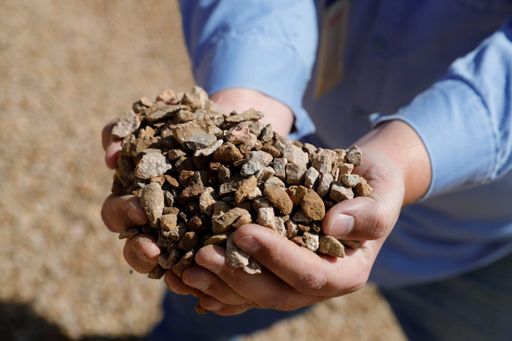From Washington to Beijing, several countries are racing to secure rare earth minerals that are crucial for technologies ranging from electric vehicles to advanced defence systems.
But few pause to ask why these critical minerals sound like they belong in a fantasy novel.
Promethium, neodymium, thulium… these may sound like spells from Harry Potter, but they are actually rare earth elements that are essential to our modern world.
Their strange names tell fascinating stories of scientific blunders, mythological inspiration, and fierce national ambition spanning 300 years.
The 17 rare earth elements, despite their misleading name, are neither rare nor earths.
The linguistic confusion began in 1788 when a Swedish miner found an unusual black rock near the village of Ytterby.
The ore was called "rare" because it had never been seen before and "earth" because that was the 18th-century geological term for rocks that could be dissolved in acid.
This misunderstanding was just the start of a naming journey that would involve stolen fire from the ancient Greek gods, mistaken identities, and mythical lands at the edge of the world.
The element named after a fire thief
Of all the rare earth names, promethium carries the heaviest symbolic meaning.
Scientists discovered this radioactive element in 1945, right in the middle of the atomic bomb project at Oak Ridge National Laboratory in Tennessee.
The timing couldn't have been more sensational. At that time, humanity split the atom and witnessed nuclear destruction that ended WWII and scarred entire generations.
The American scientists needed a name that captured both the triumph and terror of their achievement.
They turned to Greek mythology, where Prometheus was the Titan who stole fire from Mount Olympus. Then he gave it to humans, enabling civilisation but earning himself an eternal punishment – he would be an eagle eating his own liver every day, only for it to grow back each night.
Scientists explained why they chose the term Prometheus, “who stole fire from heaven for the use of mankind and for his audacity was chained to a mountain by the gods and set upon by vultures. This name not only symbolises the dramatic way in which the element may be produced in quantity as a result of man‘s harnessing of the energy of nuclear fission, but also warns man of the impending danger of punishment by the vulture of war.”
Grace Mary Coryell, wife of one of the discoverers, suggested the name. The scientists explained it would symbolise “both the daring and the possible misuse of mankind's intellect”.
The Swedish village that lent its name to four elements
This time, imagine a small mining village becoming so famous that it gets to name not one, but four elements on the periodic table. That's the remarkable story of Ytterby, Sweden.
This village's quarry, which operated from the late 1700s until 1933, produced minerals containing nine rare earth elements.
Scientists honoured this productivity by naming most of the elements after the village: yttrium; erbium, terbium, ytterbium, scandium (after Scandinavia); holmium (after Stockholm); dysprosium (‘hard to get’) and lutetium (after the Latin name for Paris, where it was finally isolated).
Another piece of a similar black ore was found to contain yet another element, which was called gadolinium.
No other place on Earth has named so many elements.
The Swedish naming spree didn't stop there. When chemist Per Teodor Cleve discovered another element in 1879, he wanted to honour Scandinavia's ancient heritage. He chose the name thulium after Thule, which he believed to be an ancient name for Scandinavia.
However, Cleve overlooked something. While Thule was associated with ancient Scandinavia, “ultima Thule” meant the absolute edge of the world, a mythical land so distant and unreachable that no one had ever set foot there.
Mapmakers in the Middle Ages placed Thule so far beyond the known world that it became more a symbol of the unknown than a real place.
Cleve even misspelt it initially, proposing “Thullium” with two L's. His new element was named after a place that might never have existed.
National rivalries
The rush to name new elements has also reflected the scientific nationalism of the 19th century.
European chemists competed fiercely to claim these discoveries, driven by national pride.
Carl Auer von Welsbach was one of them. He studied under Robert Bunsen at the University of Heidelberg in the 1880s. Bunsen was one of the most influential chemists of his time and is best known for inventing the “Bunsen burner”, a tool that became a staple in chemistry labs worldwide.
Welsbach’s training under Bunsen placed him within the powerful German school of chemistry, which was then locked in fierce competition with researchers in Sweden and France.
Multiple scientists often claimed the same discovery, eager to name new elements after their own cities.
In 1926, Italian chemists claimed they had discovered element 61 and suggested the name "florentium" in honour of Florence.
That same year, American scientists proposed "illinium," linking it to the University of Illinois. But both teams were mistaken; element 61 had not been successfully isolated.
It wasn’t until 1945 that scientists finally identified and confirmed the element as “promethium”.

Modern implications
Today, these mythological and geographical names take on new meaning.
China now controls roughly 69 percent of global rare earth production, meaning that elements named after a Swedish village, ancient Greek figures, and places like Scandinavia power Chinese-made electronics and electric vehicles worldwide.
The “fire thief” promethium is used in nuclear batteries, continuing its connection to atomic power. The "twin" elements help create the powerful magnets in wind turbines and electric motors.
Understanding these names can help us make sense of the materials that lie at the heart of the global race for clean energy and the effort to fight against climate change.
After all, behind each strange-sounding element lies a human story of ambition, rivalry, missteps, and moments of inspiration drawn from the ancient world.















